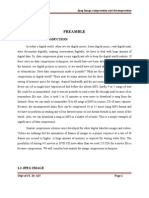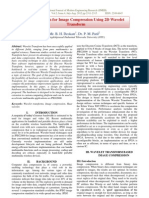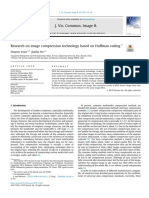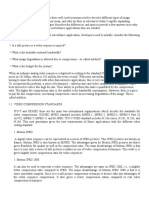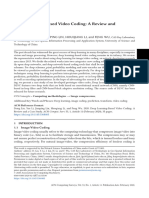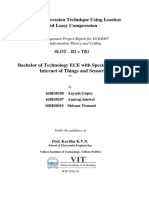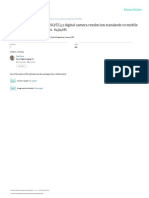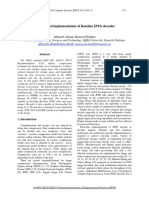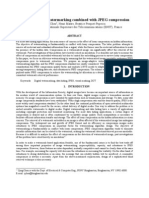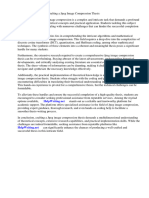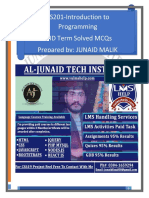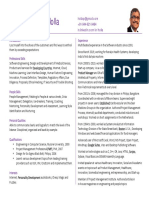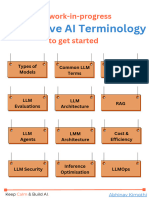JPEG XL Next-Generation Image Compression Architecture and Coding Tools
JPEG XL Next-Generation Image Compression Architecture and Coding Tools
Uploaded by
thanhmd020803Copyright:
Available Formats
JPEG XL Next-Generation Image Compression Architecture and Coding Tools
JPEG XL Next-Generation Image Compression Architecture and Coding Tools
Uploaded by
thanhmd020803Original Title
Copyright
Available Formats
Share this document
Did you find this document useful?
Is this content inappropriate?
Copyright:
Available Formats
JPEG XL Next-Generation Image Compression Architecture and Coding Tools
JPEG XL Next-Generation Image Compression Architecture and Coding Tools
Uploaded by
thanhmd020803Copyright:
Available Formats
JPEG XL next-generation image compression architecture
and coding tools
Jyrki Alakuijalaa , Ruud van Asseldonk†,a , Sami Boukortta , Martin Brusea , Iulia-Maria
Coms, aa , Moritz Firschinga , Thomas Fischbachera , Evgenii Kliuchnikova , Sebastian Gomeza ,
Robert Obryka , Krzysztof Potempaa , Alexander Rhatushnyak†,a , Jon Sneyersb , Zoltan
Szabadka†,a , Lode Vandevennea , Luca Versari*,a , and Jan Wassenberga
a
Google Research Zürich, Switzerland
b
Cloudinary, Israel
ABSTRACT
An update on the JPEG XL standardization effort: JPEG XL is a practical approach focused on scalable
web distribution and efficient compression of high-quality images. It will provide various benefits compared to
existing image formats: significantly smaller size at equivalent subjective quality; fast, parallelizable decoding and
encoding configurations; features such as progressive, lossless, animation, and reversible transcoding of existing
JPEG; support for high-quality applications including wide gamut, higher resolution/bit depth/dynamic range,
and visually lossless coding. Additionally, a royalty-free baseline is an important goal. The JPEG XL architecture
is traditional block-transform coding with upgrades to each component. We describe these components and
analyze decoded image quality.
Keywords: JPEG XL, image compression, DCT, progressive
1. INTRODUCTION
JPEG1 has reigned over the field of practical lossy image compression ever since its introduction 27 years ago.
Other mainstream media encodings, especially for video and sound, have gone through several generations of
significant and well-rounded improvements during the same time period. One can ask what are the characteristics
of JPEG and the field of lossy image compression that let JPEG keep its position in spite of all the efforts so far.
We have identified two main repeating issues in previous efforts attempting to replace JPEG with more efficient
image encodings, namely, psychovisual performance in professional quality photography and the lack of gradual
migration features. We have addressed them thoroughly in our new proposal, JPEG XL, as well as generally
improved compression performance.
As an outcome of the 79th JPEG meeting in April 2018, the JPEG Committee announced the JPEG XL
activity,2 aiming to standardize a new generation of image coding that offers substantially better compression
efficiency than existing image formats (e.g. 50% size reduction over JPEG), along with features desirable for web
distribution and efficient compression of high-quality images. Proposals were due September 1, 2018, and based
on psychovisual experiments, Google’s PIK3 and Cloudinary’s FUIF4 codecs were chosen as the base framework
for JPEG XL and its further core experiments. As of July 2019, JPEG XL has advanced into the committee
draft phase, and is being prepared for circulation in ISO’s national bodies.
The authors believe that a key factor in the failure to deliver outstanding high quality psychovisual perfor-
mance in new lossy image codecs has been their tendency to target their best performance at too low bit rates,
and the coding methods not extending to higher bit rates without losing most of their efficiency along the way.
This can be most easily observed in image codecs that are derived from successful video encoding research. To
make sure that we get this right with JPEG XL, we have gathered real-world usage data on existing JPEG
utilization, and conducted independent experiments on how this could be mapped into bit rates and quality
settings in JPEG XL. We note that as a result of this focus we have aimed at higher image qualities and bit
rates than previous efforts.
† Work done while the author was at Google.
* veluca@google.com
Applications of Digital Image Processing XLII, edited by Andrew G. Tescher, Touradj Ebrahimi,
Proc. of SPIE Vol. 11137, 111370K © The Authors. Published under a Creative Commons
Attribution CC-BY 3.0 License · doi: 10.1117/12.2529237
Proc. of SPIE Vol. 11137 111370K-1
Migrating from the previous generation of media codecs to the next generation introduces a technology tran-
sition cost. Two or more incompatible encodings of the same original data need to be maintained and managed
for different clients, often increasing storage capacity cost. Occasionally some fragmentation happens already
within a single generation of codecs, contributing additionally to the transition cost. On-line transcoding, while
practical in avoiding storage costs, has disadvantages. It introduces computational cost and additional quality
and efficiency losses. These transcoding losses can be unpredictable and more dramatic if the original in previous
generation technology has been compressed lossily to the highest possible degree, because compression artefacts
of one technology are often expensive to represent by another technology. The on-line transcoding computation
time can introduce additional latency that consumes a significant fraction of the speed up that the new generation
of codecs could otherwise offer. Additional latency is unfortunate since the user experienced latency (without
compromising on the image quality) is the main driver for a new generation of lossy image compression. The
transition costs are not limited to image quality and interoperability, but organizations deploying the new coding
system may need to load test and measure backend and end-user-experienced latencies, perform security analysis,
redo capacity planning, possibly replace old equipment, and study the impact of the technology transition on
user behavior.
This paper is structured as follows. Section 2 explains the experiments that lead the authors to focus on high
quality compression. Section 3 summarizes the features that JPEG XL supports, and the motivations behind
them. Finally, Section 4 explains the general architecture of the codec, and gives details and motivations behind
some of its components.
In this paper we show that we have solved the high quality efficiency issues that previous formats, and
particularly video formats having a second life as photography formats, tend to have. We show that we have
taken several measures to reduce the migration and interoperability concerns, ranging from supporting JPEG’s
8 × 8 DCT to enabling lossless recompression of existing JPEG images — up to a point where a file that is
byte-wise identical to the original JPEG can be reconstructed from the new JPEG XL stream.
2. MOTIVATION
Historically, technological advances have not always been associated with a direct improvement in user experience.
For example, with the initial deployment of terrestrial digital television, broadcasting companies often chose
a distribution model that slightly degraded the perceived quality of the program in favor of being able to
distribute more channels. Block artefacts started to appear in fast-moving complex scenes where the previously
uncompressed signal had uncompromised good quality. The economic pressure of having more segmentation in
the market led to a slight reduction in quality.
We would like to prevent this from happening again. Our aim is to build solutions that allow us to deliver
images faster, more economically, robustly, without surprises and with a generally better perceived quality.
There was a time in the history of the internet when downgrading the quality of media was the only option
for internet transfers to happen at bearable latencies. In those times, recording devices also used to produce
images of much lower quality than they do today. However, we no longer live in that era. The average internet
connection speed around the world is steadily increasing; it was reported at 11.03Mbps in May 2019, a 20.65%
increase compared to one year before.5 Alongside, the recording and display capabilities of current phones,
cameras and monitors often have higher resolutions than an average end user can perceive. The current digital
world is evolving towards richer and highly immersive user experiences, where images are expected to look
natural. It is safe to say that optimizing for the quality of images should be regarded as a higher priority than
optimizing for the transfer speed of lower-size images.
To find out the quality of images currently used on the web, we examined the distribution of bits per pixel
(BPP) of small, medium and large JPEG images loaded by users in Google Chrome (Figure 1). The data
was recorded by telemetry; it is pseudonymous and aggregated across users. Telemetry in Chrome is opt-out
by default and can be disabled from the browser’s “Settings” menu. We approximated the number of bytes
transferred at each BPP value by multiplying the image count for a particular BPP value with the BPP value
Proc. of SPIE Vol. 11137 111370K-2
itself. The number of transferred bytes is important because it affects the latency and hence the user experience.
Using this estimate, we calculated that between June 1st and 28th, 2019, the average BPP (weighted by the
number of bytes transmitted with that BPP) was 2.97, 2.24 and 2.03 for small, medium and large images,
respectively. We confirmed that there was no considerable difference between mobile and desktop platforms.
This data indicates that image compression algorithms should target rich images with a relatively high BPP
values, aiming to produce 1 BPP images almost free of artefacts instead of 0.5 BPP images with artefacts that
are not too intrusive.
JPEG images loaded in Chrome (1-28 June 2019)
Image size
large
Estimated transferred bytes
medium
small
(normalized)
0 1 2 3 4 5 6 7
Bits per pixel
Figure 1. Estimation of bytes transferred at each BPP value. BPP values are aggregated from pseudonymous data
collected by telemetry in Google Chrome. The images are classified by their smallest dimension (width or height) into
small (100–400 pixels), medium (400–1000 pixels) and large (1000+ pixels). The BPP distributions are aggregated across
all images loaded in Chrome across all platform from June 1st to 28th, 2019. The estimated counts are normalized for
each image size category. The mean for each image size is shown with dashed vertical lines. The BPP counts are obtained
from an order of billions of samples.
With these considerations in mind, JPEG XL is designed to handle high-quality images particularly well. Its
aim is serving the current and future needs of an increasingly rich media experience. Ideally, an image should
be compressed up to a point where there is no perceptible loss of quality from the original.
To assess the efficiency of JPEG XL over that of legacy JPEG in the task of encoding images with no
perceptible loss of quality, we performed the following experiment. We selected a corpus of 43 images consisting
of 12 images from imagecompression.info6 (IC dataset) and 31 images from a corpus provided by Jyrki
Alakuijala7 (J31 dataset). We chose the IC dataset because it is a standard benchmark for image compression,
and the J31 dataset because it is designed to capture semantically important low intensity features on a variety
of background colors, such as the fine structure of flower petals; our experience with image compression showed
that red, purple, and magenta backgrounds often cause high frequency features to be lost and that image quality
metrics have difficulty normalizing the differences across different background colors. We used all images from
each dataset, except for leaves iso 1600 and nightshot iso 100 from IC, which had duplicates at a different
ISO level. As the IC images are very large, we rescaled them so that the maximum dimension would be 1024
pixels. All IC images and 6 J31 hence corresponded to the large size category described above, while the other
25 J31 images corresponded to the medium size category.
We compressed each of the 43 images with legacy JPEG and JPEG XL at 24 different quality levels. For
images compressed with JPEG, we used libjpeg1.5.28 with a quality parameter of 40, 44, 48, 52, 56, 60, 64,
68, 72, 76, 80, 82, 84, 86, 88, 90, 92, 94, 95, 96, 97, 98, 99 and 100 for each of the 24 images respectively. For
images compressed with JPEG XL, we used default settings on the latest development version of the codec, and
Proc. of SPIE Vol. 11137 111370K-3
a distance value∗ of 8.0, 6.0, 4.0, 3.0, 2.8, 2.6, 2.4, 2.2, 2.0, 1.8, 1.6, 1.5, 1.4, 1.3, 1.2, 1.1, 1.0, 0.9, 0.8, 0.7, 0.6,
0.5, 0.4 and 0.3 for each of the 24 images respectively. For each image and compression method, we recorded
the corresponding number of bytes b and computed the bits per pixel (BPP) for that image (as 8b/(x · y) for
an image of width x and height y pixels). Finally, we decompressed the images to PNG to allow the browser to
display them without further loss.
We asked 36 healthy adult participants to indicate the lowest quality that they would find acceptable to
compress pictures with no perceptible loss of quality. All participants had normal or corrected vision and were
instructed to adjust their monitor position and chair height in order to look at the images in a comfortable and
natural position. The images were displayed on a 27” QHD monitor with a resolution of 2560 × 1440 on the
default brightness setting. All assessments were performed during daylight in a room lit by indirect sunlight.
The order of the four sets and conditions (IC JPEG, IC JXL, J31 JPEG, J31 JXL) was randomised, but always
so that the two IC sets and the two J31 sets were presented in consecutive order. For each image, the assessment
was performed by moving a slider with 25 positions to the left or to the right to adjust the compression level
of the image. The rightmost position was the starting position and it displayed the uncompressed image. The
leftmost position corresponded to the lowest compression quality and the following 23 positions corresponded to
gradually increasing compression quality levels specified above.
Out of the 3096 datapoints collected in total, we discarded 13 datapoints that were invalid due to a problem
in recording the responses that we only found after performing the experiment. As this involved a very small
number of points, we treated these as missing and discarded them.
We found that a lower BPP value was consistently selected for JPEG XL compared to legacy JPEG (Figure 2).
Pooling the results from both datasets together, the mean selected BPP was 2.09 for legacy JPEG, which is in
agreement with the Chrome statistics above. The JPEG XL distribution mode (computed using bins of size 0.1),
mean, median and skewness were 48%, 46.27%, 41.33%, and 54.7% lower than those of legacy JPEG. This effect
was preserved when splitting across sets (Figure 3) and participants (Figure 4).
350 Participant responses
JPEG
300 JXL
mode
250 mean
median
200 skewness
Count
150
100
50
0
0 1 2 3 4 5 6 7
Bits per pixel
Figure 2. All participant responses groups by condition (JPEG and JPEG XL). The mode was obtained by grouping the
data into bins of size 0.1. The histogram bin size is 0.25. For JPEG, an additional 28 responses larger than 7, with a
maximum of 13.08, are not shown here.
∗
approximately proportional to the inverse of the quality parameter of legacy JPEG, calibrated so that a distance of
1.0 corresponds to barely perceptible artefacts under normal viewing conditions
Proc. of SPIE Vol. 11137 111370K-4
0.8 Participant responses
J31 JPEG
0.7 J31 JXL
0.6 IC JPEG
IC JXL
Count (normed) 0.5
0.4
0.3
0.2
0.1
0.0
0 1 2 3 4 5 6 7
Bits per pixel
Figure 3. All participant responses grouped by condition (JPEG and JPEG XL). The histogram bin size is 0.5. The values
are normalized so that their sum per condition is 1.0/bin size = 2.0. For JPEG, the additional responses larger than 7
and not shown here sum to 0.07.
12 Mean responses per participant
JPEG
10 JXL
Number of participants
0
0 1 2 3 4 5 6 7
Bits per pixel
Figure 4. Mean responses by participant and condition (JPEG and JPEG XL). For each participant, each value was
obtained by averaging over individual dataset (IC and J31), then averaging the two values. The histogram bin size is
0.25.
These results indicate that JPEG XL yields a large improvement in the representation efficiency of high-
quality images, where no perceptible loss of quality is desired. By replacing legacy JPEG with JPEG XL, it is
possible to represent such images while almost halving the required number of bits.
3. CODEC FEATURES
JPEG XL aims to be a full-featured image codec, with support for all the features that are expected by modern
image formats. Thus, JPEG XL supports an arbitrary number of channels, including alpha and depth channels;
it also allows parallel, progressive, and partial decoding. Moreover, JPEG XL supports encoding of multiple
animation frames, with different behaviours for how each frame should be blended with the previous ones: they
can be summed, replace the full frame or a sub-rectangle, or alpha-blended. JPEG XL also supports a fully
lossless mode and a responsive-by-design mode.
Proc. of SPIE Vol. 11137 111370K-5
Websites are viewed on a large variety of devices. The concept of responsive images addresses the different
needs of phones, tablets, computers, smart watches etc. that was traditionally addressed by having separate
website versions for different devices. The responsive image feature is however an additional requirement and
it limits the format designers’ ability to make other compromises related to image quality and decoding speed.
In JPEG XL we have overcome these limitations by having a dedicated mode, modular mode, for the most
responsive use. The modular mode uses a Haar-like integral transform that can exactly recover all subresolution
images, various color space transforms to be able to better represent existing images and achieve otherwise better
compression ratios through decorrelation, and an adaptive context model to improve the efficiency of the entropy
coding step.
The two common ways to model color vision are trichromatic theory and the opponent-process theory. The
LMS colorspace represents the response of three types of cones in the human retina that are named for their
sensitivity at long (L), medium (M), and short (S) wavelengths. In JPEG XL we base color modeling on a
possibly new hybrid color theory, where we use the opponent-process theory for L and M receptors, and the
trichromatic theory for S receptors. This allows us to control quantization and decorrelation of S receptors
separately from the L and M receptors. There is lesser spatial density of the S receptors than of the L and M
receptors, leading to a lesser information density of respective perceptual fields, and the separation allows us
to accomodate for that in how we store colors. We call this colorspace XYB, where Y is the sum of L and M
signaling after reception and X is the difference. B represents the signaling of the S receptors. In JPEG XL
we model the compression through storing the cubic root of the value over the receptor’s spectral efficiency.
While this does not exactly match receptors’ compression properties — which are modeled as hybrid-log-gamma
in some other modern efforts — it is practical since it is fast to decode and the error of the receptor response
and cubic root can be stored in the adaptive quantization field, giving roughly equally efficient quantization
performance at a higher decoding speed.
4. CODEC ARCHITECTURE
This section describes the architecture of the JPEG XL image codec, as per the committee draft of the specifi-
cation.9 An overview is given in Figure 5; the rest of the section gives more details about each component.
4.1 Integral transforms
JPEG1 is fundamentally based on the 8 × 8 DCT-II algorithm by Arai, Agui and Nakajima.10 Variable-DCT
mode of JPEG XL is still based on fundamental 8 × 8 block units, but extends this approach, and allows the use
of any bidimensional DCT-II transform whose sides are one of 8, 16, or 32† . Doing so allows further reductions
in the entropy of the image for homogeneous areas; on the other hand, it creates artefacts with longer reach, and
thus the use of these transforms requires careful selection on the encoder side.
JPEG XL also supports the use of “special” transforms that cover specific use cases:
• small DCTs of sizes 8 × 4, 4 × 8, 4 × 4, and 2 × 2 cover the opposite use case of larger transforms, such as
very heterogeneous areas, for which it is important to reduce the propagation distance of artefacts. Note
that these small DCTs are still applied on 8 × 8 blocks: as an example, for the 4 × 4 DCT, the transform
is applied on each of the four 4 × 4 areas in the 8 × 8 block; coefficients are then mixed in such a way that
DC ends up in the top-left 2 × 2 corner of the block, and a 2 × 2 DCT is applied on the DC coefficients to
obtain a single DC value. Similar techniques are used to obtain a DC value for other DCTs.
• the IDENTITY transform covers the case of some pixels in the block having very different values from
nearby pixels. As for the 4 × 4 DCT, it applies a transform to each of the four 4 × 4 areas in the 8 × 8 block,
and then proceeds with shuffling the resulting coefficients and doing a 2 × 2 DCT on the DC coefficients.
†
DCT sizes other than 8 use a different DCT algorithm, described by Vashkevich and Petrovsky11
Proc. of SPIE Vol. 11137 111370K-6
Figure 5. Block diagram architecture of JPEG XL.
Proc. of SPIE Vol. 11137 111370K-7
However, the 4 × 4 transform that is used is not a DCT. Instead, the transform computes the average of
the 4 × 4 block and, for all other values of the block except the one in position (1, 1), the difference between
the value and the one in position (1, 1). Storing deltas compared to one pixel instead of deltas from the
average avoids accumulating quantization error on the missing pixel, while choosing pixel (1, 1) instead of
(0, 0) provides slightly better compression because it is more correlated with the values in the 4 × 4 block,
on average.
• the AFV transform is also similar to 4 × 4 DCT and IDENTITY, but with a different transform for each
4 × 4 area. In particular, AFV computes a basis change similar to what a DCT does, but with specialized
basis functions that allow the 3 corner pixels to be stored separately. This allows to easily encode blocks
that have an edge barely cutting through them, which gives a very different value to a few pixels in one of
the corners.
As with JPEG, JPEG XL also has special handling of DC coefficients. For transforms that are bigger than
8 × 8, this creates a problem: there is now only one DC coefficient that spans more than one 8 × 8 block.
JPEG XL handles this situation by computing X Y
8 × 8 pseudo-DC coefficients for each X × Y transform, roughly
corresponding to the average value in each 8 × 8 block, in a reversible way. This can be done thanks to the
following key observation:
Lemma 4.1. Given N and K ≤ N , there exist non-zero constants c0 , . . . , c2N −K −1 such that the following two
procedures are equivalent for any sequence of numbers a0 , . . . , a2N −K −1 :
1. Compute an inverse DCT of size 2N −K on the array c0 a0 , . . . , c2N −K −1 a2N −K −1
2. Append 2N −K · (2K − 1) elements with a value of 0 to the a0 , . . . , a2N −K −1 array, compute an inverse DCT
of size 2N on the resulting array, and replace each of the 2N −K consecutive groups of 2K values with their
average.
For example, with N = 4 and K = 3, both procedures compute the same two values, the average of each of the
two halves of a IDCT of size 16 computed on an array with 2 nonzero entries followed by 14 zero entries.
This claim can easily proven by induction on K. By choosing K = 3, and applying the lemma along both
dimensions, this allows us to compute a value that is approximately the average of each 8 × 8 block covered by
a large DCT (computed on pixel values after ignoring some higher frequencies) that also allows to completely
recover an equivalent number of low-frequency DCT coefficients, as the first of the two equivalent procedures in
Lemma 4.1 is clearly reversible.
4.2 Entropy coding
The legacy JPEG format offers the choice of using Huffman coding12 or Arithmetic Coding13 as an entropy coder.
Both of these options come with disadvantages: Huffman coding is sub-optimal when symbol probabilities are
not exact powers of two, and Arithmetic Coding implementations typically have fairly slow decoding speed.
JPEG XL uses Asymmetric Numeral Systems14 (also known as ANS), a recently-introduced entropy coder
that achieves compression ratios similar to Arithmetic Coding, while being significantly faster during decoding.
JPEG XL encodes in a single ANS stream symbols drawn from multiple different probability distributions.
Two techniques are used to give more flexibility to encoders: distribution clustering and variable-precision
distribution encoding.
A single ANS stream may contain symbols from thousands of different distributions. Encoding all of these
distributions would use a significant amount of bits, making this choice sub-optimal for all but the longest of
streams. Thus, JPEG XL allows defining clusters of similar distributions, with a single histogram being encoded
for the whole cluster. This allows more flexibility than simply using fewer distributions, as the clustering can be
defined per-file instead of being fixed. The encoding of the clusters uses a move-to-front transform and run-length
encoding to minimize the bitstream overhead.
Proc. of SPIE Vol. 11137 111370K-8
To further reduce the overhead for relatively small clusters, the encoder can choose between multiple different
representations for the distributions themselves: a simple “flat” representation (that produces histograms with
roughly uniform probabilities), useful for short streams, and a representation that stores, for each probability
value, its magnitude and a variable number of less-significant bits, controllable on a per-histogram basis, that
allows to further control the tradeoff between histogram and stream size.
Finally, to reduce the number of distinct symbols that get encoded in an ANS stream, which has beneficial
effects on both histogram size and decoding speed of the entropy coder, many parts of JPEG XL use a hybrid
unsigned integer encoding scheme: values below 16 are encoded as symbols directly, while any other value is
encoded with a symbol that allows to recover the highest 2 bits set; other bits are stored uncompressed.
4.3 Color correlation
From the definition of the XYB colorspace, it follows that a fully gray pixel will be represented as a multiple
of (0, 1, 0.935669). Keeping this representation as-is is undesirable, as it transmits the luma information on two
channels at the same time. Thus, JPEG XL applies a linear transformation to pixel values immediately after
dequantization, adding a multiple of the Y channel to the X and B channels.
In particular, the default correlation factor is 0 for the X channel and 0.935669 for the B channel: this allows
to transmit luma information using the Y channel only.
However, these factors are not necessarily optimal on areas of the image with a strong chroma component
(such as, for example, fully red regions). Therefore, JPEG XL allows altering the correlation factors locally, for
tiles of 64 × 64 pixels, with a dedicated control field.
4.4 Adaptive quantization
JPEG only allows the choice of a single quantization matrix (per channel) for the whole image. This leads to
the same amount of quantization everywhere, even if some areas have more detail and may thus benefit from
increased quantization.
In JPEG XL, the choice of quantization matrix is still global (for each given integral transform); however,
this quantization matrix can be scaled locally, to decrease artefacts in more “complex” areas without increasing
the amount of bits used in other parts of the image.
Combined with a measure of loss, this allows encoders to target a roughly uniform amount of loss across the
image, avoiding large variations.
4.5 Adaptive predictor
To improve compression ratio, legacy JPEG subtracts the value of the DC coefficient for the previously encoded
block from the DC coefficient of the current block. Because of local similarities displayed by typical images, this
results in significant savings.
However, this prediction mode is fairly primitive, and does not take into account the bidimensional nature of
images. To address this concern, JPEG XL uses a bidimensional “adaptive” predictor, that chooses between eight
different prediction modes, based on their behaviour on nearby pixels. This predictor is used for DC encoding,
but also for the encoding of various control fields.
More specifically, when predicting a value in position (x, y), the adaptive predictor looks at the maximum
error that each prediction mode would have produced on pixels (x − 1, y), (x, y − 1) and (x − 1, y − 1), and chooses
the prediction mode that is expected to produce the least amount of error. If the expected error computed this
way is 0, the adaptive predictor also keeps track of the number of prediction modes that are expected to reach
this accuracy level. The expected error and the number of “correct” prediction modes is used to split the encoded
residuals into multiple distributions. This allows significant size savings, since this procedure detects flat areas
in the image and uses specific distributions for them.
A variation of this predictor is used for lossless mode. The lossless predictor uses fewer prediction modes
(four instead of eight), but computes a weighted average of the predictions instead of choosing one of them.
Proc. of SPIE Vol. 11137 111370K-9
Figure 6. Example of banding on low quality images: left original, right compressed image.
4.6 DC handling
One of the most noticeable artefacts produced by JPEG compression at lower quality is banding, the transforma-
tion of an area of the image containing a slowly varying color (such as the sky at sunset) into one that contains
a few bands of the same color (see Figure 6). This creates very noticeable artefacts at the boundaries between
two different bands.
Banding in JPEG is typically caused by DC quantization. To avoid this effect, JPEG XL allows using finer
quantization steps for encoding residuals that are close to 0 in the original image. This is in practice equivalent
to using finer quantization steps in areas that are slowly varying, but without sacrificing compression ratio as
much as using finer quantization on the whole image would do.
To further reduce banding in areas with steeper gradients, JPEG XL applies a selective smoothing algorithm
to the DC image, that is only allowed to move values inside their quantization boundaries. If the smoothed value
would be outside of the quantization boundaries, it is discarded, and the original is used.
4.7 LF predictions
To reduce banding further, and to make block artefacts less noticeable in the resulting image, JPEG XL estimates
the low-frequency coefficients of each X × Y transform (the top-left corner of size X Y X Y
4 × 4 , excluding the 8 × 8
X Y X Y
corner) from the DC image. This procedure starts by extending the known 8 × 8 coefficients to have size 4 × 4 ,
by filling missing coefficients with zeros. It then uses the inverse of the first procedure described in Lemma 4.1
on each block to produce a 2× upsampled version of the DC image.
After applying the a smoothing algorithm similar to the one used on the DC image, the upsampled DC is
converted back to DCT coefficients; the low-frequency values that are produced this way are then added to the
encoded low-frequency coefficients.
4.8 AC encoding
JPEG always encodes AC coefficients using the so-called zig-zag order, which proceeds in order of increasing
sum of coordinates in the block.
As JPEG XL uses different transform sizes, it generalizes the zig-zag order to those cases. Moreover, since
this order is not necessarily optimal for a given image, it allows to encode a custom order. This custom order
is encoded as a permutation of the zig-zag order, using a Lehmer15 -like code to achieve efficient encoding of the
identity permutation.
The encoding of AC coefficients proceeds in the order specified above; it keeps track of the number of remaining
non-zeros in the current block, using that value, combined with the current position, to split coefficients into
multiple distributions. No further values are present in the bitstream when it is known that no non-zero coefficient
is left.
Proc. of SPIE Vol. 11137 111370K-10
Figure 7. Example of ringing on low quality images: left original, right compressed image. Because of ringing, the sky is
not flat in the regions close to the tree branches.
4.9 Loop filters
Despite the significant improvements that JPEG XL delivers to reduce artefacts, block boundaries and ringing
can still be noticed, especially at somewhat lower qualities. Ringing artefacts are spurious signals near sharp
edges, caused by quantizing or truncating high-frequency components (see Figure 7). To mitigate their impact,
JPEG XL employs two different loop filters that are applied to the image after the decompression process.
The first loop filter is a smoothing convolution. As smoothing the image inherently introduces a sharpness
loss, this effect is compensated by the encoder by means of a sharpening filter that is applied before the DCT
step. The overall effect of this procedure is that the visual impact of block boundaries gets reduced, while still
preserving sharp details present in the original image.
The second loop filter is intended to reduce ringing, while still preserving texture that is transmitted in the
image. To achieve this effect, it applies an adaptive smoothing algorithm related to Non-Local Means,16 with
some modifications to improve processing speed. To further improve the detail preservation of this filter, the
JPEG XL format can require the decoder to apply a quantization constraint to the output of the filter: the DCT
step is applied again, and the decoder ensures that the resulting coefficients are inside the range of values that
would have been quantized to the coefficient read from the bitstream by clamping. The decoder then applies an
IDCT step again to produce the final output of the filter.
4.10 Image features
Certain image features can pose challenges to the DCT and are sometimes best handled by dedicated tools. This
section presents a few such encoding tools that are specified by JPEG XL.
One such technique that JPEG XL allows is to draw splines on top of the decoded image by means of addition
in XYB space. More specifically, they consist in an approximation of centripetal Catmull-Rom splines, along
which evenly-spaced (1 pixel apart) strokes of a Gaussian brush are applied. The color of the brush and the
variance of the Gaussian kernel can vary along the spline and are each encoded using the DCT32 transform.
Another technique concerns dots, by which we mean one or very few pixels that are visibly very different
from their neighboring pixels. At lower quality, due to the nature of DCT transforms used by JPEG XL, the
disappearance of dots might be a noticeable artefact. To mitigate this effect, JPEG XL allows to draw dots that
get summed to the decoded images. Those dots are modeled as bidimensional Gaussians, which may have an
elliptical shape, with various rotations of the axes and intensities.
JPEG XL allows to add patches to an image. Patches are small pixel patterns. When those patches appear
multiple times in an image, it might be beneficial to store them only once, together with the positions where
they appear. This can be used for example to improve the appearance of compressed printed text in an image,
which is also problematic to represent in a DCT-based codec.
There is tendency that noise, when present in the original image, is lost when compressed. To recover more
realistic looking images, JPEG XL allows to add noise to the image. We employ an intensity dependent noise
model.17 A pseudorandom procedure generates the noise that is added to the image.
Proc. of SPIE Vol. 11137 111370K-11
4.11 Group splitting
If the image to be encoded is large enough (more than 256 pixels along any axis), it is split into sub-rectangles of
size at most 256 × 256, which are encoded independently. The bitstream also contains an index of the bitstream
positions of those rectangles that allows decoders to seek to the start of each.
This gives four benefits: it allows decoders to process each rectangle independently in parallel, to decode only
selected regions of large images, to rearrange rectangles (e.g. in saliency order) and to restart decoding if a prior
rectangle is corrupted.
4.12 DCT-based progressive image
The JPEG XL bitstream can contain AC coefficients in multiple passes that are summed together. This allows to
progressively encode images, by sending low-frequency coefficients first, and higher frequency coefficients later.
It is also possible to refine quality in selected regions of the image in a given pass, allowing area-of-interest
progressive decoding.
DC coefficients are always sent first, so it is always possible to obtain an 8× downsampled image from the
JPEG XL bitstream without reading the full file.
4.13 JPEG recompression
JPEG recompression allows smooth migration from legacy JPEG to JPEG XL: existing JPEG files can be
losslessly transformed to the newer and more compact format.
The legacy JPEG format has been thoroughly explored18, 19 over the years and most of its inefficiencies are
addressed in the JPEG XL recompression format:
• more robust DC coefficient prediction is used
• AC0x and ACx0 coefficients are predicted on the base of neighboring blocks
• Huffman entropy encoding is replaced with ANS and Binary Arithmetic coding
• frequently used ICC profiles, Huffman code tables, and quantization tables are encoded as template pa-
rameters
• context modeling is used to separate entropy sources
• similar to the approach described in Section 4.8, DCT coefficients are reordered in a such way that more
blocks have longer series of zeros at the end. The index of last non-zero coefficient is encoded explicitly,
which is more efficient than limited RLE.
Those improvements enable 16% size savings on average in a corpus of 100 000 random images from the
Internet. For larger photographic images, the savings are in the range 13%–22%, depending on the JPEG
encoder and quality settings.
5. CONCLUSIONS
This paper introduces the coding tools used in JPEG XL: a new approach for responsive images, and a variable-
size DCT designed from the ground up for economical storage of high-quality images.
Large-scale user metrics indicate that most use cases on the internet target higher quality levels than previ-
ously assumed in codec design. This helps explain why codecs optimized for lower bitrates have not supplanted
the 27-year-old JPEG standard. We present new quality-of-experience data indicating JPEG XL requires less
than half the bitrate of JPEG to achieve perceptually lossless storage, with fewer outliers. In other experiments,
we have found JPEG XL encodings to be 33–40% of the size of libjpeg output at similar psychovisual quality.
We acknowledge that JPEG and JPEG XL will co-exist. Rather than reduce the quality of existing images
by transcoding, or increase hosting costs by storing both formats, we propose to build a bridge between JPEG
Proc. of SPIE Vol. 11137 111370K-12
and JPEG XL. The coding tools are carefully designed to interoperate with JPEG, allowing us to shrink existing
images without quality loss and create new images that can be transcoded back to JPEG. This creates a gradual
update path which benefits both hosts and users at each step.
We believe this fresh approach will overcome previous difficulties in replacing the highly successful JPEG,
GIF, and PNG formats, and help establish a modern format that simplifies image serving, improves quality and
reduces user-experienced latency.
REFERENCES
[1] Wallace, G. K., “The JPEG still picture compression standard,” IEEE transactions on consumer electron-
ics 38(1), xviii–xxxiv (1992).
[2] “Final call for proposals for a next-generation image coding standard (JPEG XL).” https://jpeg.org/
downloads/jpegxl/jpegxl-cfp.pdf. Accessed 2019-07-26.
[3] “Github - google/pik: A new lossy/lossless image format for photos and the internet.” https://github.
com/google/pik. Accessed 2019-07-26.
[4] “Github - cloudinary/fuif: Free universal image format.” https://github.com/cloudinary/fuif. Accessed
2019-07-26.
[5] “Worldwide broadband speed league 2019.” https://www.cable.co.uk/broadband/speed/
worldwide-speed-league/. Accessed: 2019-07-25.
[6] “Image compression benchmark.” http://imagecompression.info/. Accessed: 2019-07-25.
[7] Alakuijala, J., “Image compression benchmark.” https://drive.google.com/corp/drive/folders/0B0w_
eoSgaBLXY1JlYUVOMzM5VFk. Accessed: 2019-07-25.
[8] “libjpeg 1.5.2 release.” https://github.com/libjpeg-turbo/libjpeg-turbo/releases/tag/1.5.2. Re-
leased 2017-08-09.
[9] Rhatushnyak, A., Wassenberg, J., Sneyers, J., Alakuijala, J., Vandevenne, L., Versari, L., Obryk, R.,
Szabadka, Z., Kliuchnikov, E., Comsa, I.-M., Potempa, K., Bruse, M., Firsching, M., Khasanova, R., van
Asseldonk, R., Boukortt, S., Gomez, S., and Fischbacher, T., “Committee draft of JPEG XL image coding
system,” (2019).
[10] Arai, Y., Agui, T., and Nakajima, M., “A fast DCT-SQ scheme for images,” IEICE TRANSACTIONS
(1976-1990) 71(11), 1095–1097 (1988).
[11] Vashkevich, M. and Petrovsky, A., “A low multiplicative complexity fast recursive DCT-2 algorithm,” arXiv
preprint arXiv:1203.3442 (2012).
[12] Huffman, D. A., “A method for the construction of minimum-redundancy codes,” Proceedings of the
IRE 40(9), 1098–1101 (1952).
[13] Rissanen, J. and Langdon, G. G., “Arithmetic coding,” IBM Journal of research and development 23(2),
149–162 (1979).
[14] Duda, J., Tahboub, K., Gadgil, N. J., and Delp, E. J., “The use of asymmetric numeral systems as an
accurate replacement for Huffman coding,” in [2015 Picture Coding Symposium (PCS)], 65–69, IEEE (2015).
[15] Laisant, C.-A., “Sur la numération factorielle, application aux permutations,” Bulletin de la Société
Mathématique de France 16, 176–183 (1888).
[16] Buades, A., Coll, B., and Morel, J.-M., “A non-local algorithm for image denoising,” in [2005 IEEE Com-
puter Society Conference on Computer Vision and Pattern Recognition (CVPR’05)], 2, 60–65, IEEE (2005).
[17] Khasanova, R., Wassenberg, J., and Alakuijala, J., “Noise generation for compression algorithms,”
CoRR abs/1803.09165 (2018).
[18] Lakhani, G., “DCT coefficient prediction for JPEG image coding,” in [2007 IEEE International Conference
on Image Processing], 4, IV – 189–IV – 192 (Sep. 2007).
[19] Richter, T., “JPEG on STEROIDS: Common optimization techniques for JPEG image compression,” in
[2016 IEEE International Conference on Image Processing (ICIP)], 61–65 (Sep. 2016).
Proc. of SPIE Vol. 11137 111370K-13
You might also like
- 01 Operating Manual CheckweigherDocument114 pages01 Operating Manual CheckweigherSOHAIL WAHAB0% (1)
- Jpeg Image Compression Using DCTDocument56 pagesJpeg Image Compression Using DCTRaghavendra Kulal100% (2)
- Jurisdiction in Cyber SpaceDocument23 pagesJurisdiction in Cyber SpaceNancy RohillaNo ratings yet
- Decompression of JPEG Document Images: A Survey Paper: Miss. Punam N. Kamble Mr.C. J. AwatiDocument3 pagesDecompression of JPEG Document Images: A Survey Paper: Miss. Punam N. Kamble Mr.C. J. AwatiEditor IJRITCCNo ratings yet
- Wallace - JPEG - 1992Document17 pagesWallace - JPEG - 1992floriniiiNo ratings yet
- An Algorithm For Image Compression Using 2D Wavelet TransformDocument5 pagesAn Algorithm For Image Compression Using 2D Wavelet TransformIJMERNo ratings yet
- Image Compression System Using H.264 EncodingDocument6 pagesImage Compression System Using H.264 EncodingIJSTENo ratings yet
- Thesis On Image Compression PDFDocument5 pagesThesis On Image Compression PDFlorigilbertgilbert100% (2)
- Journal of Visual Communication and Image Representation Volume 59 Issue 2019 (Doi 10.1016 - J.jvcir.2018.12.043) Yuan, Shuyun Hu, Jianbo - Research On Image Compression Technology Based On HuffmanDocument6 pagesJournal of Visual Communication and Image Representation Volume 59 Issue 2019 (Doi 10.1016 - J.jvcir.2018.12.043) Yuan, Shuyun Hu, Jianbo - Research On Image Compression Technology Based On HuffmanpusherNo ratings yet
- New Trends in Image and Video CompressionDocument7 pagesNew Trends in Image and Video CompressionSrinivasan JeganNo ratings yet
- Novel Technique For Improving The Metrics of Jpeg Compression SystemDocument8 pagesNovel Technique For Improving The Metrics of Jpeg Compression SystemInternational Journal of Application or Innovation in Engineering & ManagementNo ratings yet
- SCAN Chain Based Clock Gating For Low Power Video Codec DesignDocument7 pagesSCAN Chain Based Clock Gating For Low Power Video Codec DesignSaravanan NsNo ratings yet
- Jpeg Compression Metric As Aquality Aware Image TranscodingDocument13 pagesJpeg Compression Metric As Aquality Aware Image TranscodingcthjgfytvfnoNo ratings yet
- Lossless Recompression of JPEG Images Using Transform Domain Intra PredictionDocument12 pagesLossless Recompression of JPEG Images Using Transform Domain Intra Predictionbvkarthik2711No ratings yet
- Anjay PDFDocument17 pagesAnjay PDFAndro Elnatan HarianjaNo ratings yet
- Makalah - TA Thazin AungsoeDocument6 pagesMakalah - TA Thazin AungsoesenopatirawuhNo ratings yet
- Image Compression: by Artificial Neural NetworksDocument14 pagesImage Compression: by Artificial Neural NetworksvasuvlsiNo ratings yet
- Jpeg OptDocument141 pagesJpeg OptjatputtarNo ratings yet
- JpegDocument2 pagesJpegCoz AnimationNo ratings yet
- Design of JPEG Compression StandardDocument2 pagesDesign of JPEG Compression StandardSarah SolisNo ratings yet
- Patch-Based Image Learned Codec Using OverlappingDocument21 pagesPatch-Based Image Learned Codec Using OverlappingsipijNo ratings yet
- International Journal of Engineering Research and Development (IJERD)Document7 pagesInternational Journal of Engineering Research and Development (IJERD)IJERDNo ratings yet
- An Analysis in Various Compression AlgorithmsDocument5 pagesAn Analysis in Various Compression Algorithmssurendiran123No ratings yet
- Digital Image Forensic Approach To Counter The JPEG Anti-Forensic AttacksDocument12 pagesDigital Image Forensic Approach To Counter The JPEG Anti-Forensic Attacksasriza yolandaNo ratings yet
- Wavelet-Based Image Compression: By: Heriniaina Andrianirina #1817662 Akakpo Agbago #1817699Document19 pagesWavelet-Based Image Compression: By: Heriniaina Andrianirina #1817662 Akakpo Agbago #1817699Raja DineshNo ratings yet
- Compression TechniquesDocument7 pagesCompression TechniquesMatthew ElokunNo ratings yet
- Deep Learning-Based Video Coding - A Review and A Case StudyDocument35 pagesDeep Learning-Based Video Coding - A Review and A Case Studyqi848475885No ratings yet
- Data Communication: Assignment No: 2bDocument14 pagesData Communication: Assignment No: 2bManjesh KumarNo ratings yet
- Delivery of High Quality Uncompressed Video Over ATM To Windows NT DesktopDocument14 pagesDelivery of High Quality Uncompressed Video Over ATM To Windows NT DesktopAdy AndyyNo ratings yet
- Image CompressionDocument26 pagesImage Compressiond56468901No ratings yet
- My ProjectDocument89 pagesMy ProjectumamaheshbattaNo ratings yet
- Subjective Image Quality Tradeoff Between Spatial Resolution and Quantization NoiseDocument23 pagesSubjective Image Quality Tradeoff Between Spatial Resolution and Quantization NoiseHcv Prasad KacharlaNo ratings yet
- Computer Networks Introduction Computer NetworkingDocument21 pagesComputer Networks Introduction Computer Networkingsuraj18in4u100% (1)
- BayersDocument4 pagesBayersprojectinbangalore279No ratings yet
- Error Detection and Data Recovery Architecture For Motion EstimationDocument63 pagesError Detection and Data Recovery Architecture For Motion Estimationkasaragadda100% (1)
- Digital Video Concepts Methods and Metrics Quality Compression Performance and Power Trade Off Analysis 1st Edition Shahriar Akramullah (Auth.)Document84 pagesDigital Video Concepts Methods and Metrics Quality Compression Performance and Power Trade Off Analysis 1st Edition Shahriar Akramullah (Auth.)zhanareege100% (2)
- The Jpeg2000 Still Image Coding System: An Overview: Senior Member, IEEE Senior Member, IEEE Member, IEEEDocument25 pagesThe Jpeg2000 Still Image Coding System: An Overview: Senior Member, IEEE Senior Member, IEEE Member, IEEEVignesh sankar uNo ratings yet
- Image Compression Using Huffman CodingDocument25 pagesImage Compression Using Huffman CodingAayush GuptaNo ratings yet
- Literature Review On Different Compression TechniquesDocument5 pagesLiterature Review On Different Compression TechniquesInternational Journal of Application or Innovation in Engineering & ManagementNo ratings yet
- Joint Photographic Experts Group: Unlocking the Power of Visual Data with the JPEG StandardFrom EverandJoint Photographic Experts Group: Unlocking the Power of Visual Data with the JPEG StandardNo ratings yet
- T E V V: A S S T C A: HE Volution of Olumetric Ideo Urvey of Mart Ranscoding and Ompression PproachesDocument11 pagesT E V V: A S S T C A: HE Volution of Olumetric Ideo Urvey of Mart Ranscoding and Ompression Pproachesgeek.bill.0No ratings yet
- Applying and Extending ISOTC42 Digital Camera ResoDocument10 pagesApplying and Extending ISOTC42 Digital Camera ResoChiNo ratings yet
- 5615 Ijcsa 06Document11 pages5615 Ijcsa 06Anonymous lVQ83F8mCNo ratings yet
- Haar Wavelet Based Approach For Image Compression and Quality Assessment of Compressed ImageDocument8 pagesHaar Wavelet Based Approach For Image Compression and Quality Assessment of Compressed ImageLavanya NallamNo ratings yet
- Jpeg Image Compression Using FpgaDocument2 pagesJpeg Image Compression Using FpgaInternational Journal of Application or Innovation in Engineering & ManagementNo ratings yet
- MPEG-2 Long GoP Vs AVC Comp-StrategiesDocument22 pagesMPEG-2 Long GoP Vs AVC Comp-Strategiessathis_nskNo ratings yet
- JPEG Image Compression and Decompression by Huffman CodingDocument7 pagesJPEG Image Compression and Decompression by Huffman CodingInternational Journal of Innovative Science and Research TechnologyNo ratings yet
- Video Saliency Detection Using Modified High Efficiency Video Coding and Background ModellingDocument10 pagesVideo Saliency Detection Using Modified High Efficiency Video Coding and Background ModellingIJRES teamNo ratings yet
- MpegDocument2 pagesMpegumar khanNo ratings yet
- Design and Implementation of An Optimized Video Compression Technique Used in Surveillance System For Person Detection With Night Image EstimationDocument13 pagesDesign and Implementation of An Optimized Video Compression Technique Used in Surveillance System For Person Detection With Night Image EstimationChetan GowdaNo ratings yet
- Lossless Video Compression For Archives: Motion JPEG2k and Other OptionsDocument8 pagesLossless Video Compression For Archives: Motion JPEG2k and Other Optionsmbush6000No ratings yet
- Video Database: Role of Video Feature ExtractionDocument5 pagesVideo Database: Role of Video Feature Extractionmulayam singh yadavNo ratings yet
- Discovering Robustness Amongst CBIR FeaturesDocument13 pagesDiscovering Robustness Amongst CBIR FeaturesijwestNo ratings yet
- Fractal Image Compression-A ReviewDocument4 pagesFractal Image Compression-A Revieweditor_ijarcsseNo ratings yet
- FPGA Based Implementation of Baseline JPEG DecoderDocument7 pagesFPGA Based Implementation of Baseline JPEG DecoderUmar AnjumNo ratings yet
- Efficient Algorithm For Digital Image SteganographyDocument6 pagesEfficient Algorithm For Digital Image SteganographySuraj VernekarNo ratings yet
- Compression of Hyperspectral Image Using JPEG Compression AlgorithmDocument9 pagesCompression of Hyperspectral Image Using JPEG Compression AlgorithmInternational Journal of Innovative Science and Research TechnologyNo ratings yet
- Oblivious Image Watermarking Combined With JPEG CompressionDocument9 pagesOblivious Image Watermarking Combined With JPEG Compressionray11145No ratings yet
- Jpeg Image Compression ThesisDocument6 pagesJpeg Image Compression Thesisgjga9bey100% (1)
- Image Compression Using VerilogDocument5 pagesImage Compression Using VerilogvisuNo ratings yet
- Image, Video Compression Techniques: JPEG, MPEG: Seminar Report OnDocument55 pagesImage, Video Compression Techniques: JPEG, MPEG: Seminar Report Onpriyanka07422No ratings yet
- Image Compression: Efficient Techniques for Visual Data OptimizationFrom EverandImage Compression: Efficient Techniques for Visual Data OptimizationNo ratings yet
- LM 7131Document28 pagesLM 7131NathanNo ratings yet
- CS201 MIDTERM SOLVED MCQS by JUNAIDDocument47 pagesCS201 MIDTERM SOLVED MCQS by JUNAIDAzhar Dogar100% (3)
- Baggage Handling: by Sharmin Naz 1 Year Mba in Aviation ManagementDocument19 pagesBaggage Handling: by Sharmin Naz 1 Year Mba in Aviation ManagementSharminNo ratings yet
- EZVIZ Camera - Guide Démarrage RapideDocument34 pagesEZVIZ Camera - Guide Démarrage Rapiderom1486No ratings yet
- MSSIAH WavePlayerDocument21 pagesMSSIAH WavePlayerReno Wrestlehoff2No ratings yet
- DX DiagDocument42 pagesDX DiagCao Cường ĐỗNo ratings yet
- Ai Unit2 RejinpaulDocument81 pagesAi Unit2 RejinpaulJohnwilliam PNo ratings yet
- 2020 Cohort Handout On Chapter 17.2-17.3 - Further Differentiation - Teacher'sDocument18 pages2020 Cohort Handout On Chapter 17.2-17.3 - Further Differentiation - Teacher'sSharia NehaNo ratings yet
- Have Get Something Done British English Student PDFDocument3 pagesHave Get Something Done British English Student PDFAlejandro GarcíaNo ratings yet
- Multimedia System - Quiz 2Document22 pagesMultimedia System - Quiz 2Alesa DaffonNo ratings yet
- Your Electronic Ticket Receipt (1) GarudaDocument2 pagesYour Electronic Ticket Receipt (1) GarudaindahNo ratings yet
- Asc Installation Instructions 4189341076 UkDocument29 pagesAsc Installation Instructions 4189341076 UkEmmanuel ValiaoNo ratings yet
- A Landscape Orientation Resume TemplateDocument1 pageA Landscape Orientation Resume TemplatePadmanabha HollaNo ratings yet
- Installation: Base Transceiver Station Equipment Imn:Btse Bs40Document62 pagesInstallation: Base Transceiver Station Equipment Imn:Btse Bs40AlexandarNo ratings yet
- Labour Relations Practice QuizDocument8 pagesLabour Relations Practice QuizGavin WallNo ratings yet
- User Manual: WWW - Tcl.euDocument20 pagesUser Manual: WWW - Tcl.euFilipe ConceiçãoNo ratings yet
- Lesson 7 GEE 5 IT EraDocument3 pagesLesson 7 GEE 5 IT Erastephaniejeancortez522No ratings yet
- Geospatial Analytics For IoTDocument4 pagesGeospatial Analytics For IoTDyutish BandyopadhyayNo ratings yet
- "Atm Management System": VENKATESHA GS. (2GO19CS038) NAWAZ ALI. (2GO19CS046)Document9 pages"Atm Management System": VENKATESHA GS. (2GO19CS038) NAWAZ ALI. (2GO19CS046)Barath KtNo ratings yet
- State Wise Aadhaar SaturationDocument3 pagesState Wise Aadhaar SaturationRaghavendranNo ratings yet
- Sudheer ResumeDocument3 pagesSudheer Resumesudheer munagalaNo ratings yet
- Artificial IntelligenceDocument16 pagesArtificial Intelligencenegari1174No ratings yet
- Curriculum of Certificate Course in Medical Transcription: Syllabus andDocument8 pagesCurriculum of Certificate Course in Medical Transcription: Syllabus andJustin JaspherNo ratings yet
- WC LAB Manual FinalDocument73 pagesWC LAB Manual FinalhtasarpnuraNo ratings yet
- инструкция Yamaha BRX-750Document169 pagesинструкция Yamaha BRX-750евгенийNo ratings yet
- Cs3451-Ios Revision 2 Q&aDocument7 pagesCs3451-Ios Revision 2 Q&ajeevankumar2708No ratings yet
- Generative Ai TerminologyDocument26 pagesGenerative Ai TerminologyDiksha AggrawalNo ratings yet
- Book Report - 1177 - AIDocument9 pagesBook Report - 1177 - AIsairamteja nekkantiNo ratings yet

